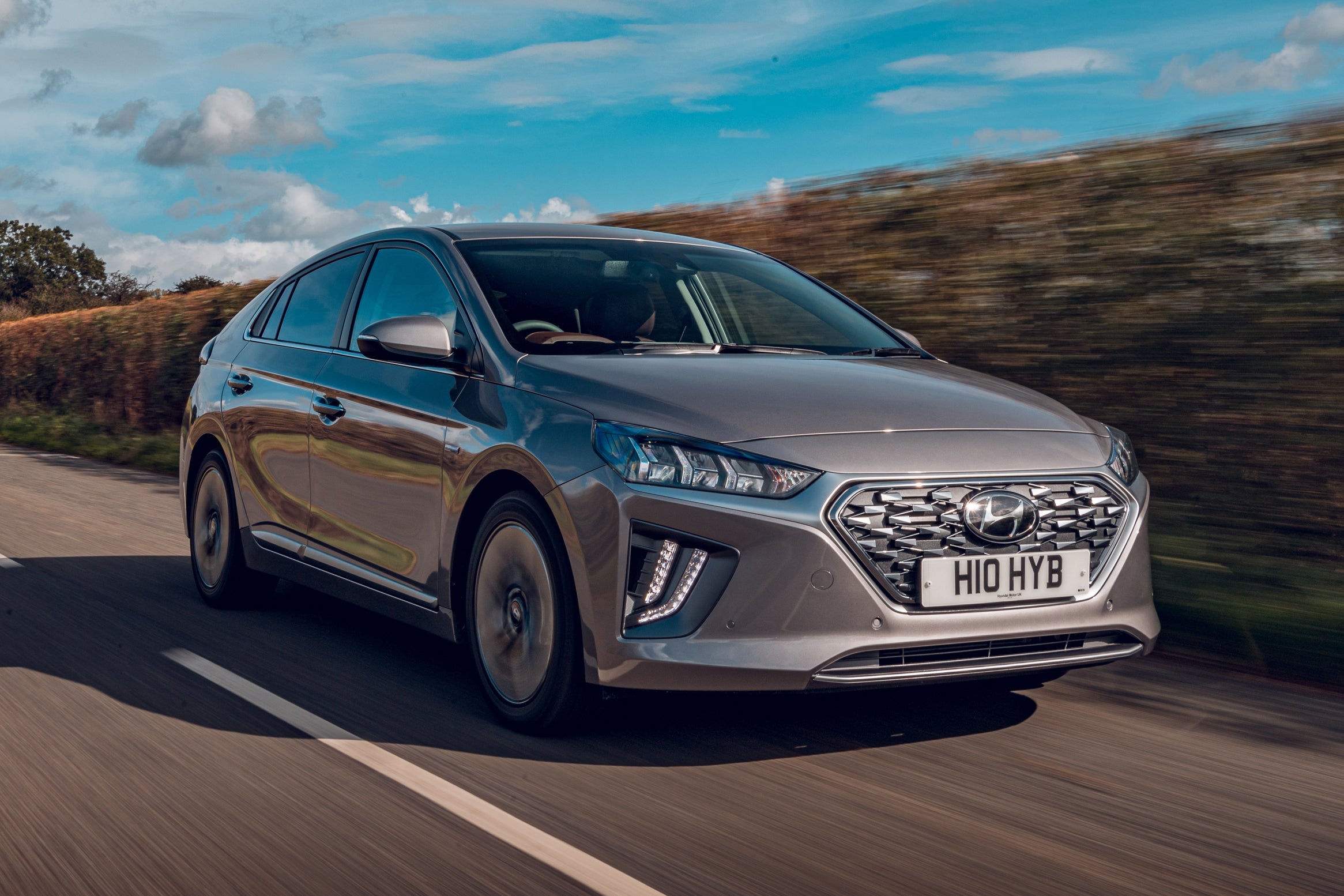Hyundai Ioniq (2016-2022) Review
Written by Andrew Brady
Quick overview
Pros
- Well priced and cheap to run
- Choice of three electrified powertrains
- Premium specification comes well equipped
Cons
- EV is range not as good as rivals
- Tight rear-seat headroom
- Toyota Prius is even cheaper to run
Verdict: Is the Hyundai Ioniq a good car?
"Whether you were ready to go fully electric for your driving in 2016 or wanted to take a step in that direction, the Hyundai Ioniq had an option to suit thanks to hybrid, plug-in hybrid, and full EV versions that all looked broadly the same. And they still hold an appeal today as an affordable use choice."
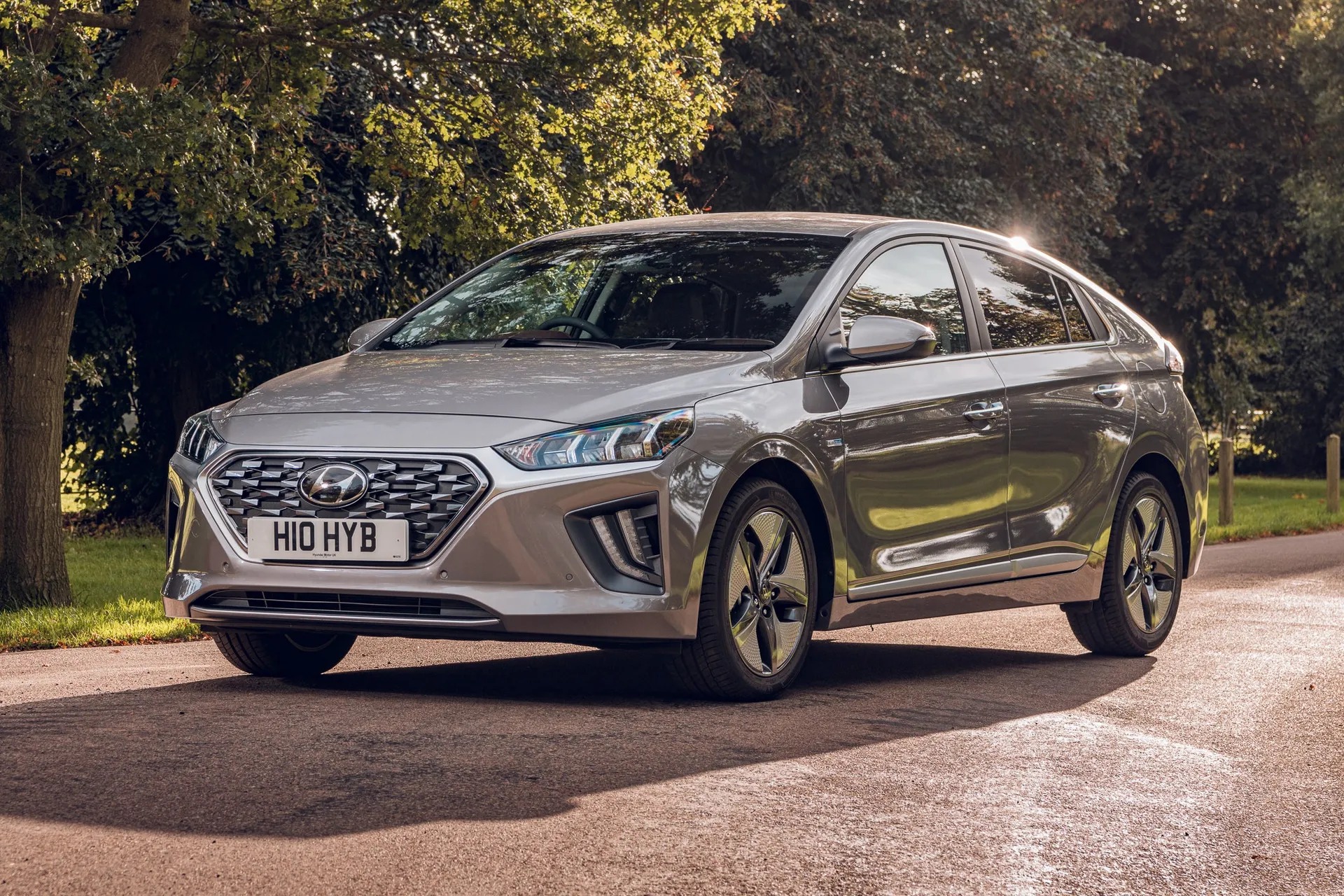
Whichever Hyundai Ioniq you go for, they look almost identical – squint and you’ll see the all-electric version has a blanked off grille – but they all share a rakish rear window tapering to an upright tail for excellent aerodynamics without seriously compromising the Ioniq’s practicality. But which one should you buy? We'll explore all the options in our Hyundai Ioniq review.
The Hyundai Ioniq self-charging hybrid uses a 1.6-litre petrol boosted by an electric motor that blends in power to save fuel or it can offer a full electric mode at low speeds for short periods. The small battery that powers it scavenges its power back when coasting, braking or by using the petrol engine as a generator.
For a greater electric-only range, you’ll want the Hyundai Ioniq PHEV (plug-in hybrid), which has a larger battery and can run for a claimed 32 miles on electric power alone - enough to cover most daily commutes. That means you can slash your running costs – charging takes a little over 2hrs from a home wall charger and costs pence rather than pounds – while still having a conventional petrol engine to fall back on for longer journeys.
Above that plug-in model sits the pure electric Hyundai Ioniq, which has an electric-only range of up to 193 miles according to official numbers. It’s ideal if you only ever drive in the city, where an electric car is at its most efficient.
Whichever Hyundai Ioniq you go for, you’ll find they’re all easy to drive with light controls and easy performance, while reversing sensors and a camera are fitted across the range. The hybrid and PHEV Hyundai Ioniq models, meanwhile, have a twin-clutch gearbox that’s a big improvement on the droning CVT gearbox that’s fitted to the Toyota Prius hybrid of the same period.
Inside, the Hyundai Ioniq’s cabin is dominated by an 8-inch infotainment screen that shows you exactly what its high-tech powertrain is getting up to, but everything else is pretty conventional. Interior quality is good with soft-touch plastics used on the dashboard and the tops of the doors.
What’s not so good is rear seat space, which is eaten into by the car’s sloping roofline and will leave taller passengers brushing their heads off the headlining. Up front, you’ll get comfortable even if you're more than six-foot tall and the boot is also large enough for a set of suitcases.
As a result, if you’re looking to buy your first used electric, PHEV or hybrid, the Hyundai Ioniq should make the transition as smooth as possible while providing a worthy alternative to the default choice that is the Toyota Prius.
Looking for a used car for sale? We've got 100s of Hyundai Approved Used Cars for Sale for you to choose from, including a wide range of Hyundai Ioniq Electric cars for sale.
Is the Hyundai Ioniq right for you?
The Hyundai Ioniq provides electrification for most drivers' needs. The self-charging model is perfect as an alternative to a diesel hatchback, while the plug-in Hyundai Ioniq PHEV is an excellent pick for those wanting emissions free short journeys, with the additional peace of mind of plentiful range from the petrol engine should you need it. For those wanting an inexpensive fully electric car, then the Hyundai Ioniq’s also got you covered.
What's the best Hyundai Ioniq model/engine to choose?
That really depends on your circumstances. The standard hybrid Hyundai Ioniq model will return excellent fuel economy and makes most sense if you don’t have somewhere to charge a car. On the other hand, if you do have somewhere to charge it and have a short commute, the Hyundai Ioniq PHEV could save you a fortune getting you to and from work. The Hyundai Ioniq electric model, meanwhile, could be the car for you if you have room to charge it and don’t need a car for long hauls up the motorway.
What other cars are similar to the Hyundai Ioniq?
The most obvious rival to the self-charging and plug-in models is that hybrid trailblazer the Toyota Prius or Toyota Prius Plug-In. That’s not offered as a pure electric though so you’ll need to visit Nissan for a Nissan Leaf, or Volkswagen for its Volkswagen ID.3.
The Ioniq’s closest rival, and the only other model to offer the three differing powers within a single body is the Kia Niro and Kia e-Niro. It’s more SUV-like in its looks, though rather than the more conventional look of the Ioniq. There is also Hyundai's own Hyundai Kona and Hyundai Kona Electric.
Comfort and design: Hyundai Ioniq interior
"Hyundai might be a bit radical in offering a trio of powertrain choices with the Ioniq, but, sensibly, it’s not gone too wild with the interior styling."
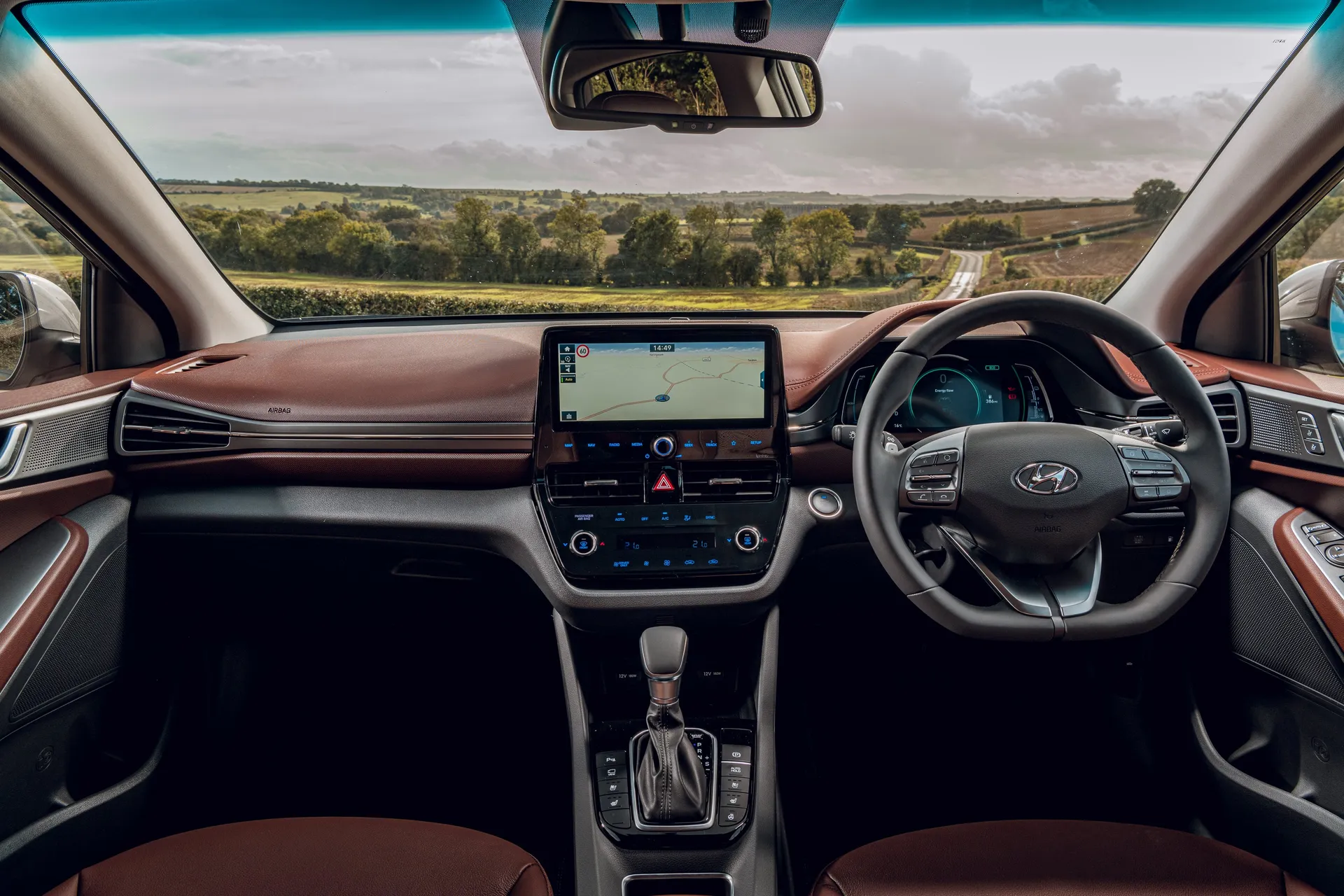
That was particularly true of the launch models, which were very ordinary inside, though Hyundai has added a bit of flair – not too much, mind – to the post-2019 facelifted models. The changes are mostly centred around the large touchscreen in the dash of the Hyundai Ioniq, though the dashboard itself gets a nice tapered shape that adds some visual interest without being as odd as its key Toyota Prius contemporary. A pleasant enough looking cabin, then, that all works with clarity and ease.
Getting comfortable behind the wheel of the Hyundai Ioniq is just as simple, as there’s plenty of adjustment to the driver’s seat and steering column. It’s manual on SE Connect and Premium models, with Premium SE gaining electrical adjustment with a memory function.
All come with electrically controlled driver’s lumbar support, two-zone climate control, rear parking sensors and a reversing camera. SE Connect cars are the only ones to do without heated front seats, keyless entry and a rear seat vent.
Hyundai Ioniq Premium SE models, meanwhile, gain ventilated front seats and heated outer rear seats, while all but the SE Connect come with keyless go and push-button start.
Quality and finish
Time was you paid for Hyundai’s generous standard equipment and attractive pricing with interior materials that were a little bit sub-par for the mainstream class. That’s not the case with the Hyundai Ioniq, with most of its cabin materials being soft to touch.
There is some evidence of the sort of hard, scratchy plastics that used to dominate, but they’re positioned low in the cabin of the Hyundai Ioniq and in areas you’ll rarely, if ever, touch. That’s more apparent in the post-2019 facelifted cars with their smarter interior styling, the cabin not just getting a visual lift but a boost in quality.
The heater controls are an exception, with Hyundai replacing the simple physical buttons of the pre-facelifted Ioniq with touch sensitive ones that are a pain to use.
Infotainment: Touchscreen, USB, nav and stereo in the Hyundai Ioniq
Avoid the SE Connect Hyundai Ioniq if you’re after the best infotainment, it is only offered with the regular hybrid and makes do with conventional instruments instead of the 7-inch TFT screen in every other Hyundai Ioniq.
Likewise, it has a smaller 8-inch infotainment touchscreen, though it does have Android Auto, Apple CarPlay, Bluetooth connectivity, USB inputs and DAB radio as standard.
Hyundai Ioniqs above it in the range add sat nav, with Bluelink (Hyundai’s connected services), Infinity Sound System, a wireless charging pad for your phone and that larger 10.25-inch central touchscreen and 7-inch screen in place of conventional instrumentation.
Hyundai’s touchscreen system operates with real ease, with clear sub menus and simple navigation, with key functions of Map, Nav, Radio, Media and Set Up all having shortcut buttons below the main screen, likewise there’s a physical volume knob. 2021-on facelifted cars place the infotainment screen more prominently in the upper middle of the dash.
Steering wheel controls for audio, cruise control and your telephone are also included as standard on every model.
Space and practicality: Hyundai Ioniq boot space
The Hyundai Ioniq measures 4470mm long and 1820mm wide, which sees you get plenty of space up front for the driver and passenger, with ample seat adjustment, a pair of cupholders and useful cubby storage throughout.
It’s not quite so generous for space in the rear seats of the Hyundai Ioniq, and that’s due to the sloping profile of the roof. Headroom is at a premium, especially if you’re above average height.
That sloping roof of the Hyundai Ioniq also makes it trickier when getting children into child seats in the back, though the two outer seats having ISOFIX child seat mounts. There’s a third, rear, central seatbelt, but the seat it covers is narrow and high, so it’s only really for occasional, short trip use, which is also true of all of the Ioniq’s direct rivals.
The Hyundai Ioniq's boot is accessed by a large hatchback and its size varies depending on what powertrain you go for. The largest boot capacity comes with the standard Hyundai Ioniq hybrid, with 443-litres with the seats in position, or 1505-litres when folded. The electric Hyundai Ioniq model sees those figures drop to 357-litres and 1417-litres, respectively, while the Hyundai Ioniq PHEV has the smallest boot capacity of the lot with the seats up at 341-litres and 1401-litres with them down.
Handling and ride quality: What is the Hyundai Ioniq like to drive?
"Built for economical motoring, it’s no real surprise that the Hyundai Ioniq isn’t the last word in excitement on the road."
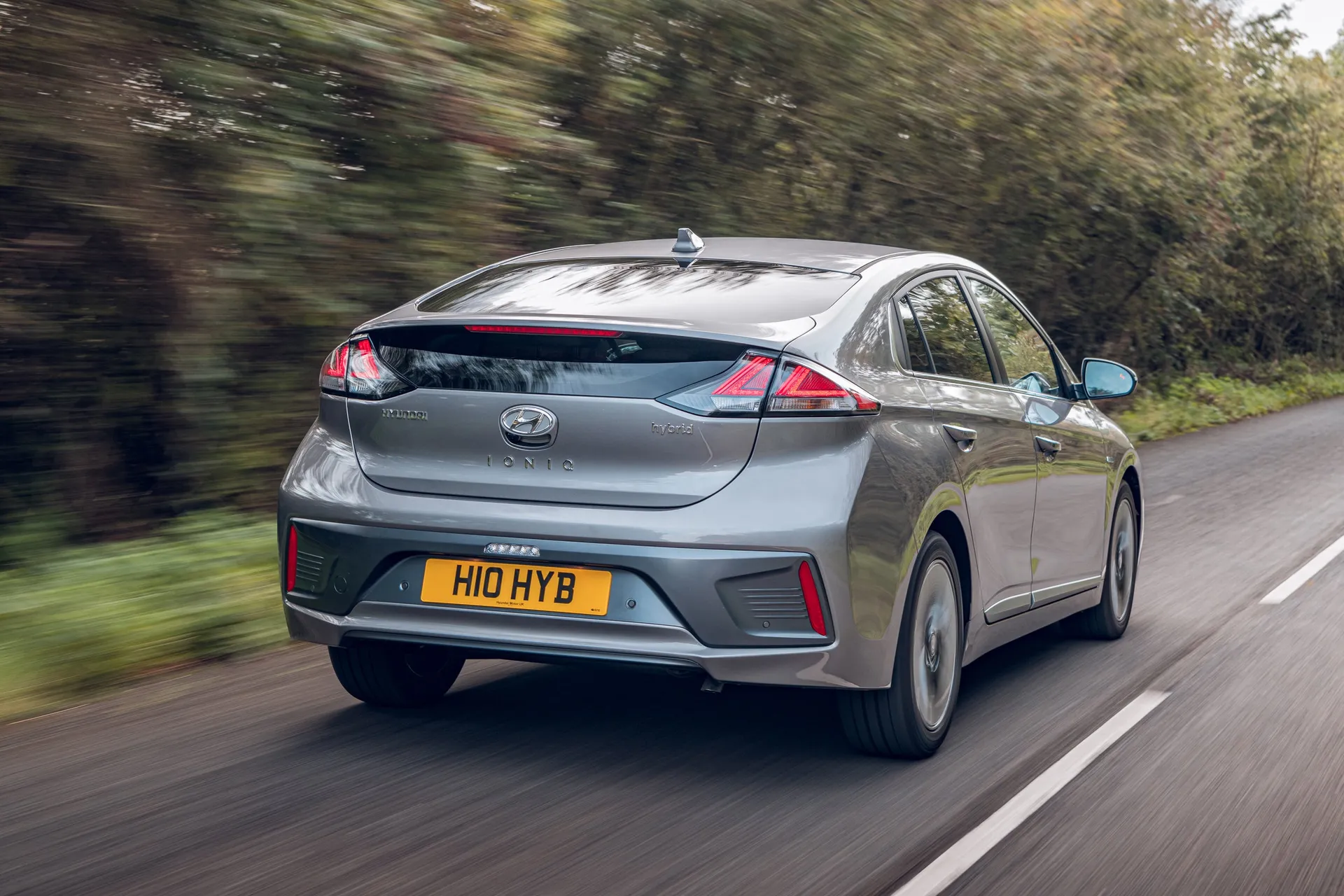
The Hyundai Ioniq is all about competence, so you’ll find light and easy steering mated with surefooted handling. There's a fair amount of body roll in the bends, underlining that the suspension is focussed on soft-riding comfort rather than high-speed corner control. But, while around town the suspension takes the edge off the poor surfaces, the worst of the bumps do knock through to the interior.
There’s a little bit more lean and scrub from the front wheels in the bends with the Electric Hyundai Ioniq, largely due to its greater mass, though all in all Hyundai has done a commendable job in making the brake pedal feel natural, despite having brake regeneration which can make brakes hard to modulate.
In fact, you can change the level of regeneration, giving the effect of engine braking when you lift off the accelerator, doing so allows you to drive virtually with one pedal. That makes the Hyundai Ioniq extremely comfortable to drive in town, particularly when you factor in its quiet electric running and standard automatic gearbox (actually a single gear in the electric model).
What engines and gearboxes are available in the Hyundai Ioniq?
There’s no gearbox on the electric Hyundai Ioniq model, but the hybrid and plug-in hybrid Hyundai Ioniq models get a six-speed twin-clutch automatic and it is responsive in a way the CVT (continuously variable transmission) that’s favoured by the Toyota Prius isn’t.
Leave the Hyundai Ioniq hybrid to its own devices and it’ll do a good job of juggling the electric and petrol motors to produce their best economy and performance.
Both hybrids produce combined power output of 141PS and 147Nm of torque, despite the plug-in Hyundai Ioniq hybrid having a more powerful 60.5PS (over 43.5PS) electric motor helping it. The latter gets from 0-62mph in 10.8 seconds while the former manages it in 10.6 seconds.
The electric motor in the Hyundai Ioniq Electric produces 136PS, its acceleration feeling brisk and it covers the 0-62mph dash in 9.9 seconds in Sport mode, or 10.2 seconds in Normal mode.
Hyundai Ioniq range: How far can you travel on a charge?
The Hyundai Ioniq Electric manages an official range of 193 miles, so a real-world 150 miles should be possible. The plug-in hybrid has a 32-mile electric-only range on a full charge. In a best case scenario, it’s likely to be closer to 25 miles if you’re driving it sensibly. It’s worth noting that both go further than pre-facelifted models which have less power dense batteries.
Refinement and noise levels
Good refinement is a by-product of hybrid and EV propulsion and that’s clear with the Hyundai Ioniq, the Electric being hushed on the move, with only the faintest hint of electrical noise from the motor, and a bit of road and wind noise as the speeds rise. Even so, it’s largely quiet, particularly so at urban speeds.
The hybrid Hyundai Ioniq models flit between their electric motor and engine smoothly, though ask a lot from the powertrain and the engine does get a bit boomy at higher revs.
Low rolling resistance tyres (if they're still fitted on a used example) and the slippery body shape of the Hyundai Ioniq, meanwhile, do their bit across the range as your speed rises.
Safety equipment: How safe is the Hyundai Ioniq?
The Hyundai Ioniq achieved a five-star score in 2016 when it was crash tested by independent safety body Euro NCAP.
All Hyundai Ioniqs come with traction and stability control, automatic emergency brakes and a driver attention alert system that warns you when you need to take a break. A lane departure warning system and lane assist help keep you in lane, you get tyre pressure monitors and ISOFIX mounts for the safe fitting of child seats. All models also come with front, side, curtain and driver’s knee airbags.
Even if you are involved in an accident, Hyundai’s e-call can summon the emergency services – sending them the location of the accident.
Premium SE models of the Hyundai Ioniq also benefit from Blind Spot Detection, active cruise control, and rear cross traffic assist – or automatic emergency brakes that work in reverse.
When Hyundai updated the whole Ioniq range in early 2019, all models received the Hyundai SmartSense pack. This provides automatic emergency braking, lane keep assist, and driver fatigue warning.
MPG and fuel costs: What does a Hyundai Ioniq cost to run?
Charging the Hyundai Ioniq Electric to 80 per cent can take less than 1 hr on a 50kW public high capacity charger. It could be as much as 19 hrs from a typical home three-pin socket, so you're much better off getting a home wallbox fitted to slash that time to six hours.
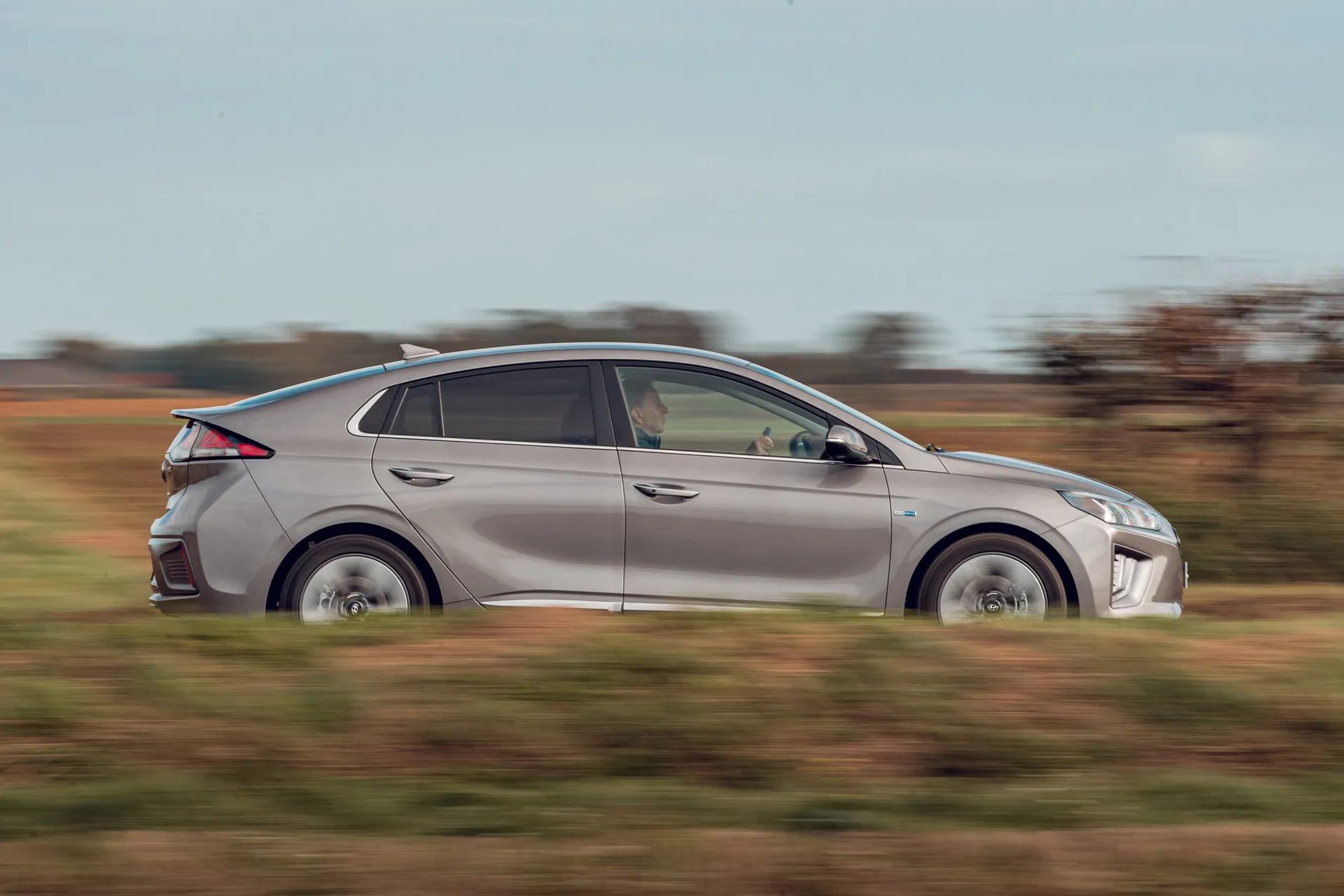
The same 7kW charger will fill the plug-in hybrid Hyundai Ioniq to full in two hours 15 minutes, or use a three-pin home socket and it’ll take between five and six hours. The official WLTP mpg for the plug-in is 256.8mpg, but the reality is more likely to be around 70-80mpg on longer drives. The regular hybrid Hyundai Ioniq will get around 60mpg if you drive it sensibly.
Hyundai Ioniq reliability and warranty
Hyundai as a brand performs very well in HonestJohn.co.uk's Satisfaction Index, achieving a score of 9.38/10 for reliability. It's also ranked seventh out of 29 car manufacturers overall, while the Hyundai Ioniq whas performed impressively for its own satisfaction score over the years.
Hyundai Ioniq insurance groups and costs
The Hyundai Ioniq is in groups 10 and 11 for the Premium and Premium SE hybrids, with the plug-in Hyundai Ioniq going up a group to 12. The more expensive Hyundai Ioniq Electric is in groups 16 to 17 depending on trim level.
VED car tax: What is the annual road tax on a Hyundai Ioniq?
With changes to the way Vehicle Excise Duty, or road tax, is calculated from April 2025, used EVs and hybrids will pay the same as petrol or diesel cars. That means all Hyundai Ioniq models will attract an annual payment of £195 for road tax at the time of writing.
Hyundai Ioniq price
"If you’re prepared to put up with minicab-like high miles then you can pick up an Hyundai Ioniq for less than £8000 used, though there aren’t many at this level."
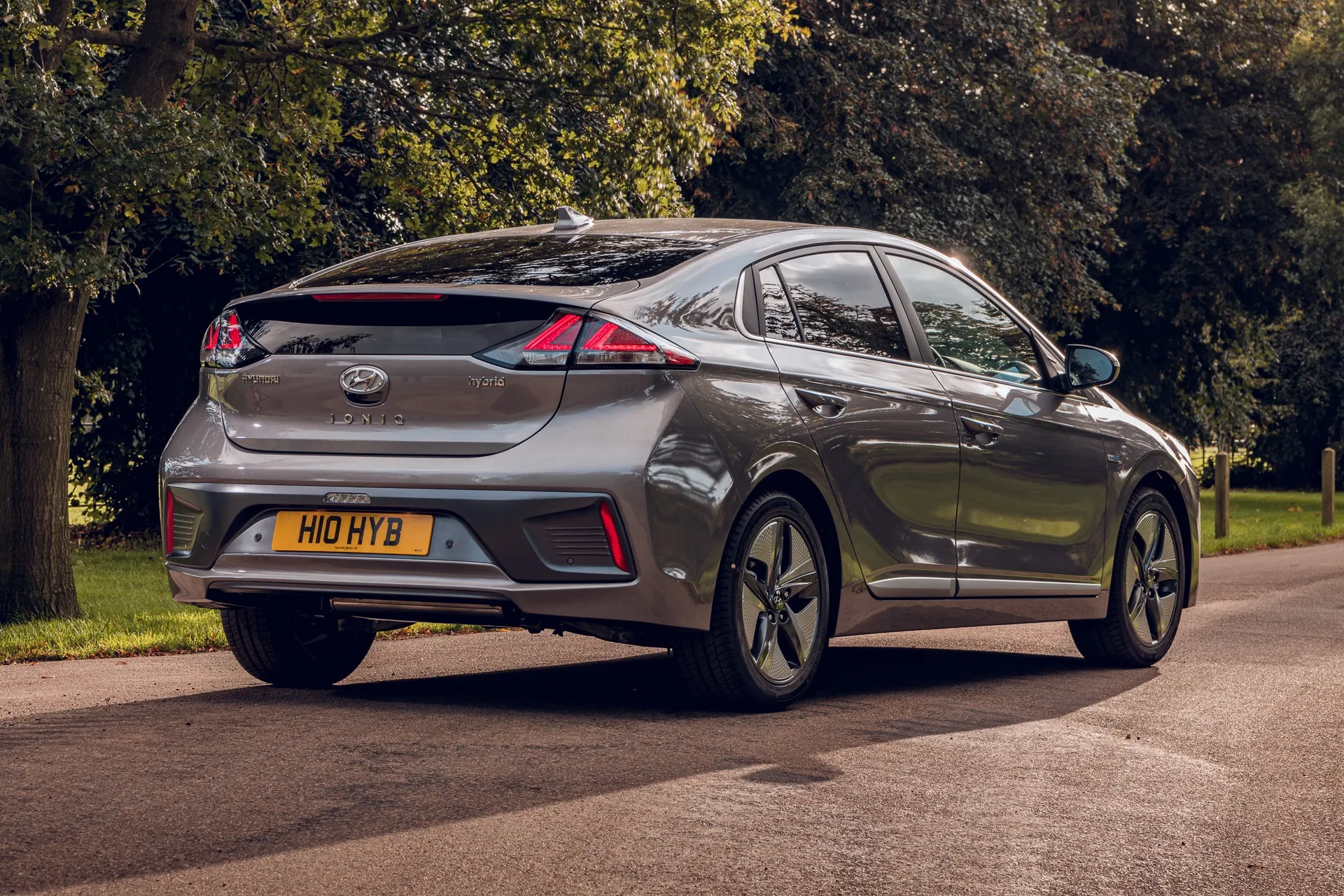
Best think of £10,000 as a starting point then, and doing so will get you into a number of Hybrid or Electric Hyundai Ioniq models with mileages around 60,000 miles. These cars will be at the five-year old mark, too.
There’s a good deal more choice from around £12,000 for all versions of the Ioniq.
Hyundai offers a five-year warranty that’s transferrable, so there are still plenty of Hyundai Ioniqs running around with the balance of this cover still there as a protection.
Trim levels and standard equipment
The Hyundai Ioniq range kicks off with Connect trim. That includes 15-inch alloy wheels, an eight-inch touchscreen media centre with Android Auto and Apple CarPlay, Automatic headlamps, cruise control and climate control. Ioniqs are born for the city so it’s good to see all models have reversing sensors and a camera.
The Hyundai Ioniq Premium adds heated front seats and a heated steering wheel, keyless entry, a more powerful infinity stereo, wireless phone charging and a larger 10.25-inch touchscreen. Premium models look a touch more modern on the outside thanks to their bright-shining LED headlights.
Hyundai Ioniq Premium SE models take another step up the ladder with 17-inch alloy wheels. They feel significantly posher on the inside thanks to their leather seats, which are electrically adjustable, heated and ventilated up front, and heated in the back.
The Premium SE also enjoys automatic wipers, blind spot detection tech, cruise control with adaptive speed control with stop & go system, and driver’s seat electric adjustment and memory. On top of there, there's leather upholstery, heated and ventilated front seats, lane follow assist, rear cross traffic alert, and heated outer rear seats.
Ask the heycar experts: common questions
Is the Hyundai Ioniq a good car?
Is the Hyundai Ioniq self charging?
Are all Hyundai Ioniqs automatic?
Are hybrid cars worth it?
Get our latest advice, news and offers
Keep me updated by email with the latest advice, news and offers from heycar.
By submitting you agree to our privacy policy
